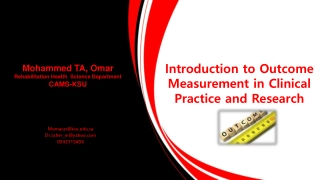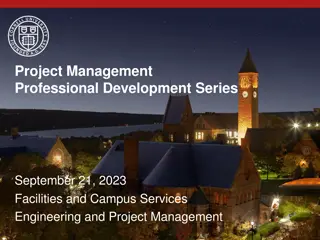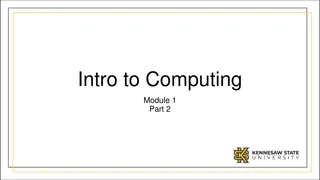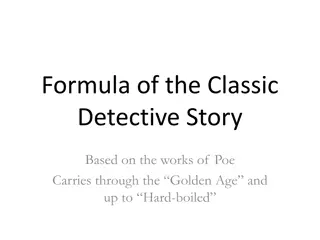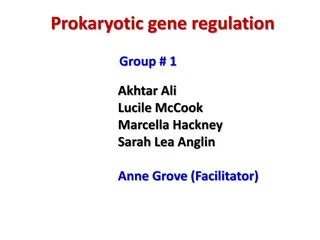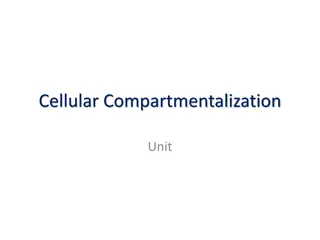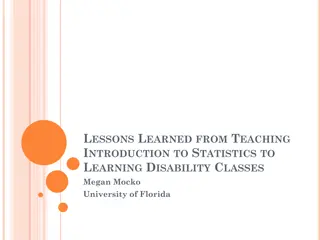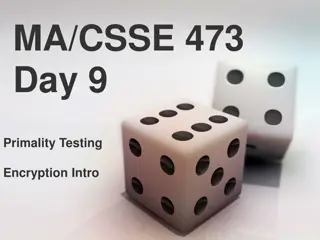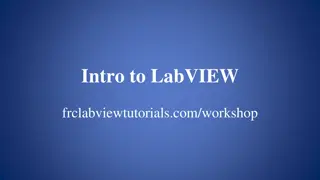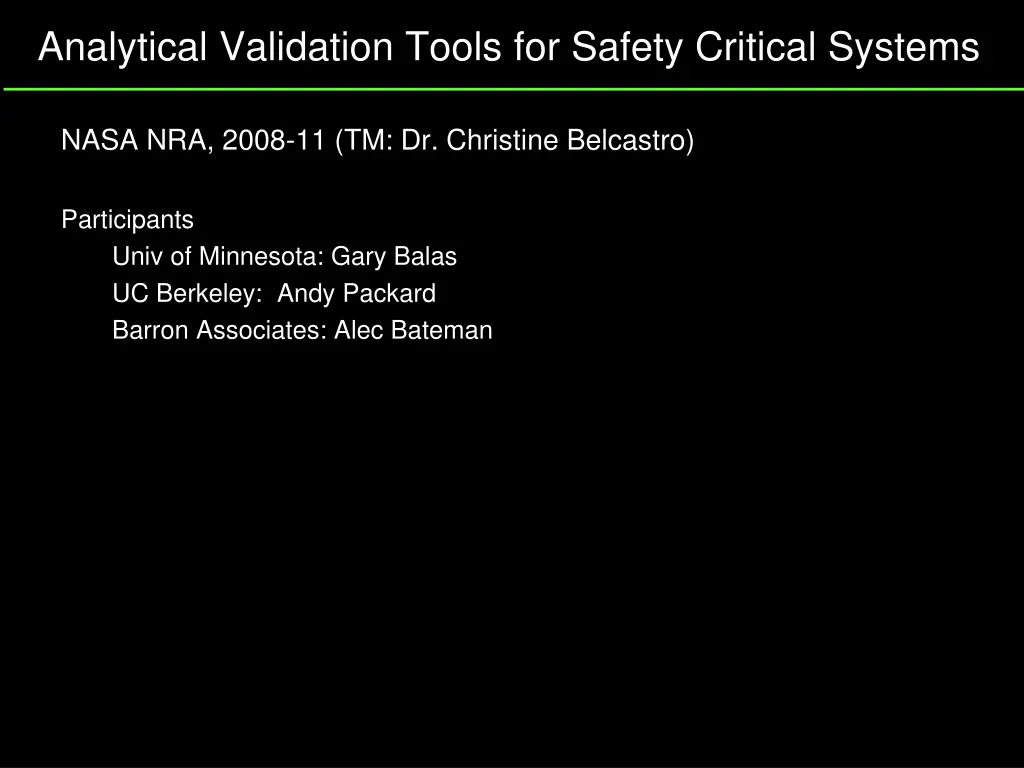
Analytical Validation Tools for Safety Critical Systems NASA NRA
Explore analytical validation tools for safety critical systems developed by NASA in collaboration with Dr. Christine Belcastro and other participants. Learn about the linear analysis, nonlinear analysis, and region-of-attraction methodologies used for certifying dynamic behavior in high-dimensional systems.
Download Presentation

Please find below an Image/Link to download the presentation.
The content on the website is provided AS IS for your information and personal use only. It may not be sold, licensed, or shared on other websites without obtaining consent from the author. If you encounter any issues during the download, it is possible that the publisher has removed the file from their server.
You are allowed to download the files provided on this website for personal or commercial use, subject to the condition that they are used lawfully. All files are the property of their respective owners.
The content on the website is provided AS IS for your information and personal use only. It may not be sold, licensed, or shared on other websites without obtaining consent from the author.
E N D
Presentation Transcript
Analytical Validation Tools for Safety Critical Systems NASA NRA, 2008-11 (TM: Dr. Christine Belcastro) Participants Univ of Minnesota: Gary Balas UC Berkeley: Andy Packard Barron Associates: Alec Bateman
Our Perspective Linear analysis: provides a quick answer to a related, but different question: Q: How much gain and time-delay variation can be accommodated without undue performance degradation? A: (answers a different question) Here s a scatter plot of margins at 1000 trim conditions throughout envelope Why does linear analysis have impact in nonlinear problems? Domain-specific expertise exists to interpret linear analysis and assess relevance Speed, scalable: Fast, defensible answers on high-dimensional systems Here s a scatter plot of guaranteed region-of-attraction estimates, in the presence of 40% unmodeled dynamics at plant input, and 3 parametric variations, at 1000 trim conditions throughout the envelope Extend validity of the linearized analysis Infinitesimal local (with certified estimates) Address uncertainty
Overview Numerical tools to quantify/certify dynamic behavior Locally, near equilibrium points Analysis considered Region-of-attraction, input/output gain, reachability, establishing local IQCs Methodology Enforce Lyapunov/Dissipation inequalities locally, on sublevel sets Set containments via S-procedure and SOS constraints Bilinear semidefinite programs always feasible Simulation aids nonconvex proof/certificate search Address model uncertainty Parametric Uncertainty Parameter-independent Lyapunov/Storage Fcn Branch-&-Bound Dynamic Uncertainty Local small-gain theorems
Nonlinear Analysis = = ( ), ( ) 0 x f x f x Autonomous dynamics equilibrium point uncertain initial condition, Question: do all solutions converge to ) 0 ( x G x = = ( , ), ( ) 0 , x 0 x f x w f Driven dynamics equilibrium point uncertain inputs, , w w R 2 z = (x ) h Question: how large can get? = = or ( , ) ( , , ) x f x x f x w Uncertain dynamics Unknown, constant parameters, Unmodeled dynamics Same questions
Region-of-Attraction and Reachability V 1 p 2 3 By choice of positive-definite V, maximize so that: Dynamics, equilibrium point ( ), x f x = p = ( ) f x 0 p 1 : ( ) x p x : ( ) 1 is bounded x V x : , ( ) 1 x x x V x : ( ) 1 x V x p: Analyst-defined function whose (well-understood) sub- level sets are to be in region-of- attraction : ( ) x p x x dV dx : ( ) f x 0 x ROAx dVf dx 0 = Given a differential equation and a positive definite function p, how large can get, knowing ( ) e t ( , ) f x w x n n + R Conditions on w dVf x w dx 2 T on all ( , ) : ( ) x V x , w w R w = (0) w 0 R x 2 : ( ) x V x : ( ) x p x R 2 Conclusion on ODE = = ( , ) ( ) p x x e f x w = (0) w 0 R x e w for all solution exists and t , ( ) e t 2
Solution Approach 1. Sum-of-squares to (conservatively) enforce nonnegativity if i i = 2 for some f f g g i 2. Easy (semidefinite program) to check if a given polynomial is SOS 3. S-procedure to (conservatively) enforce set containment 4. Apply S-procedure to Analysis conditions. For (e.g.) reachability, minimize (by choice of si and V) such that ( ) ( ( 2 ( , ) R V s f x w w w dx ) 2 p s R V 1 , x w dV ) + 2 T , x w 5. SDP iteration: Initialize V, then a) Optimize objective by changing S-procedure multipliers b) Optimize objective by changing V c) Iterate on (a) and (b) 6. Initialization of V is important for the iteration to work a) Simulation of system dynamics yields convex constraints which contain all feasible Lyapunov function candidates. This set can be sampled to initialize V
Quantitative improvement on linearized analysis Consider dynamics x Ax = + These SOS/S-procedure formulations are always feasible using quadratic V 23( ) f x where matrix A is Hurwitz, and function f23 consists of 2nd and 3rd degree polynomials, f23(0)=0 A nonempty region-of-attraction is certified Consider dynamics Bw Ax x + = = + + + + ( , ) ( ) ( ) f x w f x g x w For some R>0, 2 3 2 ( ) z Cx h x 2 w R z w where matrix A is Hurwitz, and f2, g2, h2 quadratic, f3 cubic with f2(0,0)=f3(0)=h2(0)=0, and A sI C ) ( 2 2 2 B 1 Consider dynamics Ax x = = + + ( , ) b x x Ew For some R>0, 1 1 x 1 2 ( ) x q 2 1 remains bounded w R x where matrix A is Hurwitz, and functions b bilinear, q quadratic 2
Sum-of-Squares Sum-of-squares (SOS) decompositions (Parrilo) certify nonnegativity, and (with S-procedure) certify set containment conditions A polynomial f, in n real-variables is SOS if it can be expressed as a sum-of-squares of other polys, = j 1 p = 2 f g notate as f n j SDP decides SOS: For f with degree 2d q = i q + such that R 0 f M M 0 n i i 1 Each Mi is s s, where 2 1 + n + n + n + n 2 d d d d = = + s q 2 d d d d 2
(s,q) dependence on n and 2d 2 1 + n + n + n + n 2 d d d d = = + s q 2 d d d d 2 ( ( ) DIE ) ( ) DIE DIE ( ) DIE 2d SOS SOS SOS SOS 2 4 6 8 n 2 3 0 6 6 10 27 15 75 3 4 0 10 20 20 126 35 465 4 5 0 15 50 35 420 70 1990 6 7 0 28 196 84 2646 210 19152 8 9 0 45 540 165 10692 495 109890 10 11 ( 0 2 66 1210 286 33033 1001 = f ( ( ) w w w x f V + , 457743 = = = ) ( ) 4 V V ( ) 2 V ( ) 6 V + , n n n x x w ( V = ) s = 2 = = ( ) 2 1 ) 3 T z f f ( ) 3 ( ) 3 f T ( . .) : e g DIE R z + 1 SOS n n w
Region-of-atraction: 4-state aircraft example Aircraft: Short period longitudinal model, pitch axis, with 1-state linear controller q 2 = + + + Eliminate parameter uncertainty ( , ) ( , ) ( , ) ( , ) z f z u f z u f z u f z u = z 1 1 2 2 3 1 z u = c 1 = c + C A B c location CG , z 1 3 mass , 2 2 T = + ( : ) x p z z Simple form for shape factor: Different Lyapunov function structures Quadratic ( cert=8.6) Fully quartic (quadratic + cubic + quartic) cert=15.3 4000 simulations 3 minutes discover divergent Form LP/ConvexP 0.5 minutes trajectories Get a feasable point 1 minute Assess answer with V 0.5 minutes SDP Iterate from V 0.5 min/iteration, 10 iters Other approaches have deficiencies Directly use commercial BMI solver (PENBMI) cert=15.2, but 6 hours TOTAL 10 minutes (0= x ROA ) 16 1 . : ( ) 15 3 . p x p x Certified set of convergent initial conditions Divergent initial condition Disk in 4-d state space, centered at equilibrium point
4-state aircraft example w/uncertainty Aircraft: Short period longitudinal model, pitch axis, with 1-state linear controller q = z 2 1 = + + + ( , ) ( , ) ( , ) ( , ) z f z u f z u f z u f z u 1 1 2 2 3 CG , location 1 z u = c 1 = c + C A B mass , c z 2 3 Not-uncertain results Quadratic ( cert=8.6) Fully quartic ( cert=15.3) Divergent IC, 2 T = + ( : ) x p z z Same form for shape factor: 9-processor Branch-&-Bound Divide worst region into 9 (0= x ) 16 1 . p 1 15 0.5 2 10 upper bound 0 (V) = 4 lower bound 5 -0.5 (V) = 2 lower bound -1 -1 0 1 1 0 0 1 2 3 4 number of iterations
Unmodeled dynamics: Local small-gain theorem M Local induced gain constraint ( 1) on dVf x w w w h x h x dx x = : z w = = ( ) ( ) w t ( ( ), ( )) ( ( )) t t g k t z t 2 T T on ( , ) ( ) ( ) ( ) l x ( ) V x R z w Implies: Starting from x(0)=0, for all 2,T w M z 2, 2, T T R = = ( ) ( ) z t ( ( ), ( )) ( ( )) h x t x t f x t w t w x 1 causal, globally stable, also satisfies DIE = + : S dSF d V Q 2 2 l ( ) ( ) ( ) 2 on S R dQg d ( , ) ( ) T T ( ) k z ( ) k z z z z l This gives: { : ( ) 2 }invariant, ROA S R { : ( ) S 2 2 {( ,0): ( ) x } } V x R R
4-state aircraft example w/uncertainty 2 1 = + + + ( , ) ( , ) ( , ) ( , ) z f z u f z u f z u f z u 1 1 2 2 3 .75 z C = C P 1 u = c + 1.25 A B cu u c z c c 3 with M, CG 5.1 (7.5) 2.4 (4.1) Results Nominal with Nominal 8.6 (15.3) 4.2 (6.7) 2 T = + ( : ) x p z z 2 T = + + ( : ) x ( ) p z z Q x 2 2 angle-of-attack (x2) 1 1 pitch rate (x1) 0 0 -1 -1 -2 -2 0 5 10 0 5 10 time time
Adaptive System: reachability example analysis Model-reference adaptive systems ( ( + ) ) K = x x x PB x x x m r m Reference model K = r x x PB r r m = + + x A x B u Ed = + x A x B r T x T r = m m m m u K x K r - u Adaptive control plant e Quadratic vector field, marginally stable linearization d x Example: 2-state P, 2-state ref. model, 3 adaptive parameters Insert additional disturbance (d) Bound worst-case effect of external signals (r,d) on tracking error (e) Initial conditions: m x x = ) 0 ( , 0 ) 0 ( T x T r = + = = , 0 ) 0 ( , ) 0 ( A B K A B K B m m Reachability analysis certifies that for all (r,d) with then for all t, 95 . 0 2 2 ( ) 2 e t r 0.8 d r d 0.6 1 0.4 inputs There are particular r and d satisfying r 0 E2 0.2 -1 0 = . 0 95 d -0.2 2 0 5 10 time 15 20 -2 -1 0 1 2 E1 causing e to achieve at some time t. ( e 2= ) 5 . 1 t
Wrapup/Perspective Extensive simulation Proofs of behavior with certificates and linearized analysis Tools that handle (cubic, in x, vector field) 15 states, 3 parameters, unmodeled dynamics, analyze with (V)=2 7 states, 3 parameters, unmodeled dynamics, analyze with (V)=4 Certified answers, however, not clear that these are appropriate for design choices Sproc/SOS/DIE more quantitative than linearization Linearized analysis: quadratic storage functions, infinitesimal sublevel sets SOS/S-procedure always works Work to scale up to large, complex systems analysis (e.g., adaptive flight controls) where certificates are desired.




